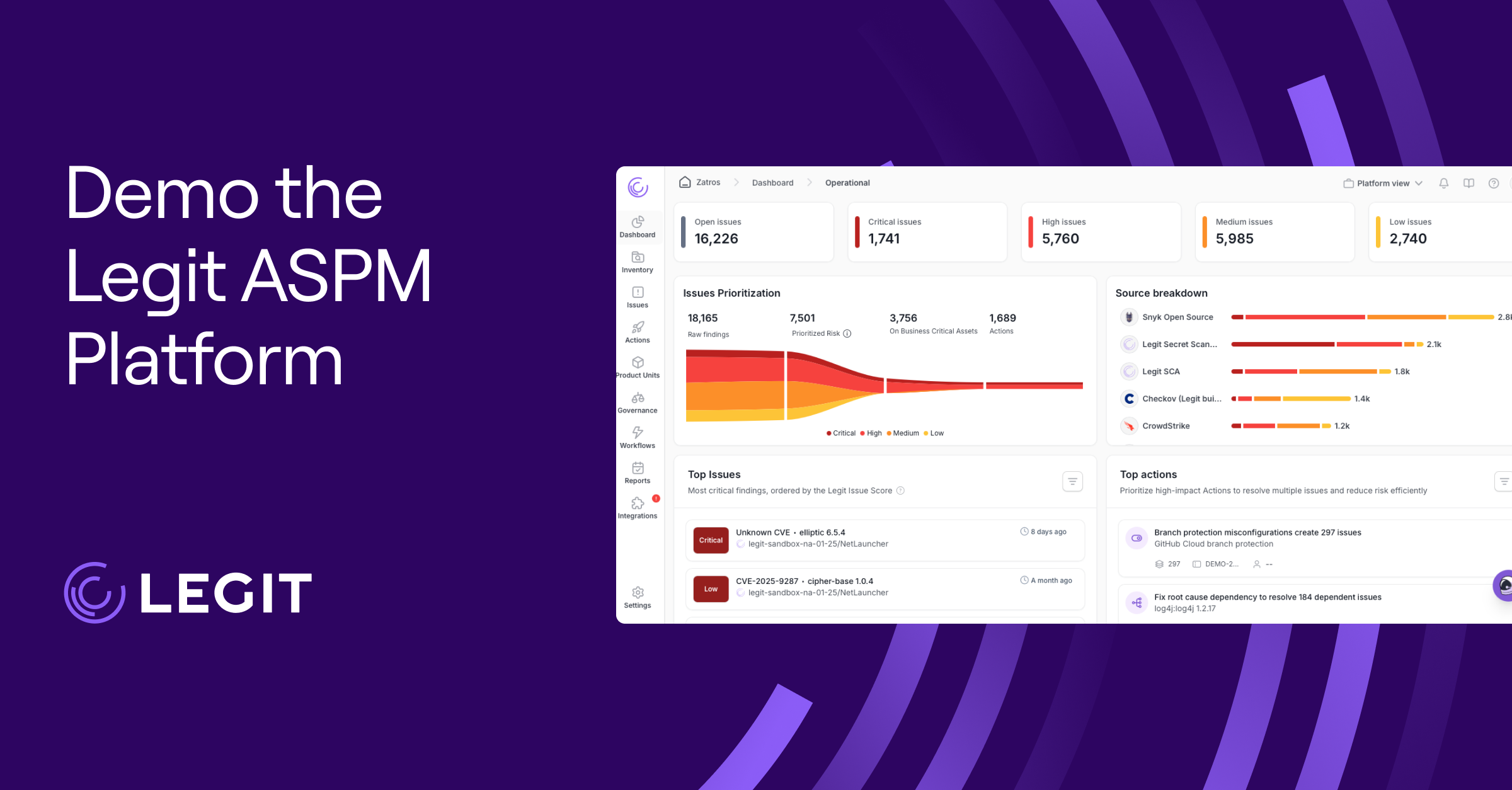Find out the key capabilities of secret scanners and what to consider when searching for a solution.
Background
In today’s software development ecosystem, software architectures rely on rapid communication between microservices and access to cloud and third-party resources. Facilitating these transactions are a multitude of authentication credentials, commonly referred to as secrets.
Managing these secrets securely is no easy feat since they play a role in every step of the SDLC: from SCM systems through CI/CD pipelines and finally into cloud infrastructure. A common place for secrets to appear is in source code - data gathered by Legit Security indicates that, on average, 12 valid secrets are found per 100 repositories. Once a secret reaches a Git-based repo, finding and removing it becomes especially challenging as it may be tucked away, hiding in a side branch, and still copying itself onto every developer's machine, possibly finding its way to the public domain.
Yet code repositories are far from the only place secrets can end up. Through mistakes or mismanagement, they can also make their way to artifacts and containers, build logs, cloud assets, and sometimes even wikis. These locations can pose an even more significant threat, as they are often intentionally public, unlike source code that is usually kept privately.
What exactly is the scale of secret leak risks? It’s the second most common initial attack vector, according to IBM’s 2023 Data breach report. Recently, a GitHub personal access token belonging to a Mercedes-Benz employee was found in a public repository The discovery was subsequently disclosed, and evidence showed that the token held access to Mercedes code and other secrets, including valid AWS and Azure keys. While the original token was revoked, it remains to be seen if any malicious actor found it prior to the report and used it to access intellectual property or customer data. This incident shows that the inadvertent disclosure of even one sensitive secret can lead to a cascade of breaches that will undoubtedly be costly and difficult to remediate.
What to Look for in a Secret Scanner
How should organizations handle the risk of secrets exposure? Training employees and keeping them up to date with best practices helps, but true protection requires more. Secret scanners add automated safeguards that complement these efforts, resulting in a stronger, more effective secret management solution.
Here’s what to consider when evaluating scanning tools for modern codebases.
Comprehensive Coverage
As mentioned, secrets can end up across your entire development environment, from your Git history and GitHub repositories to Docker containers, artifacts, and knowledge management systems like Confluence. Choose a secret scanning tool that can detect sensitive information such as API keys, credentials, and configuration files in any location. Effective secret management requires broad detection capabilities that cover your full infrastructure and source code.
Custom Pattern Matching
Look for a secret scanning tool that allows you to define custom detection patterns, a feature that lets you enforce rules for code repositories. For example, you may want to validate that regular expressions follow a consistent pattern. A customizable tool will flag any code that doesn’t meet your predefined rules, helping you detect leaked sensitive information early.
Version Control System (VCS) Integration
Secret management doesn’t end at your current codebase—it includes historical code versions that may contain sensitive information like exposed API keys, passwords, or old credentials. Pick a scanner that integrates with GitHub and other VCS platforms to scan past commits for vulnerabilities. This way, current and previous repositories won’t contain hardcoded sensitive data.
Real-Time Scanning and Alerts
Secret detection needs to run continuously, checking your source code and codebases for sensitive data on an ongoing basis. When the scanner detects a potential leak, it should immediately send alerts to the right team to remedy the issue. Continuous scanning may produce more false positives, but it’s a small tradeoff for preventing leaked API keys, configuration files, and other sensitive data.
Production-Grade Capacity
Secret scanning is only valuable if it can handle enterprise-scale codebases. You might have hundreds of repositories, thousands of code commits, and complex CI/CD workflows. A scanner that can’t keep up could miss sensitive information or slow your release cycle. Many open-source tools lack the capabilities to scan large environments or properly integrate with infrastructure as code pipelines. Look for a solution that’s designed for security at scale.
Context-Based Assessment
Not all secrets pose the same security threat. Sensitive credentials, tokens, and API keys vary in importance and risk level. A valid hardcoded password in a public repo demands immediate action, while an expired secret in Confluence might not. Advanced scanning tools prioritize detection and remediation based on risk, which improves your entire security protocol.
Reliable Detection
A good secret scanning tool minimizes false positives that waste developer time and false negatives that let sensitive information slip through. Accurate detection capabilities are critical for maintaining strong security without overwhelming teams with noise.
Management and Response
Scanners use all the above capabilities to flag exposed secrets, but secret management involves so much more. Once a scanner detects hardcoded credentials or other sensitive data, it should issue alerts through your workflow (such as Slack or Jira) and help you prioritize fixes. Tools with strong management capabilities are key to guiding teams through secure remediation steps and reducing long-term vulnerabilities.
Customization
Every organization faces unique secret management challenges. The best scanning tools let you add custom patterns and adjust severity levels. They also manage exceptions for specific configuration files, code lines, or paths within repositories. This ups the accuracy of their detection and minimizes unnecessary false positives.
Prevention Capabilities
Detecting leaked secrets is one way to address a breach, but the best approach is to block sensitive information before it’s ever hardcoded or leaked into a repo. A strong tool can deploy locally, run pre-commit hooks, and prevent API keywords, passwords, and configuration files from entering your GitHub repositories or production containers. That kind of early detection and prevention dramatically reduces future vulnerabilities.
Legit is here to help
Having a secrets scanner that can check all these boxes can go a long way in strengthening overall security posture. Legit’s Secret Scanner provides a best-of-breed solution that covers everything we outlined in this post and more. Want to see for yourself? Book a demo with Legit Security today.
To learn more about secrets and their role in your software supply chain, read Legit Security’s latest white paper.
You can also, for a limited time, request a Free Trial of the Legit Secrets Scanner.
Download our new whitepaper.


